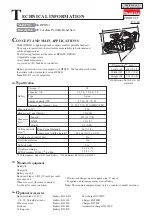
10 ENGLISH
Cutouts
Cutouts can be made with either of two methods
“Boring a starting hole” or “Plunge cutting”.
Boring a starting hole
For internal cutouts without a lead-in cut from an edge,
pre-drill a starting hole 12 mm or more in diameter.
Insert the jig saw blade into this hole to start your cut.
Plunge cutting
You need not bore a starting hole or make a lead-in cut
if you carefully do as follows.
1.
Tilt the tool up on the front edge of the base with
the jig saw blade point positioned just above the work
-
piece surface.
2.
Apply pressure to the tool so that the front edge of
the base will not move when you switch on the tool and
gently lower the back end of the tool slowly.
3.
As the jig saw blade pierces the workpiece, slowly
lower the base of the tool down onto the workpiece
surface.
4.
Complete the cut in the normal manner.
Finishing edges
To trim edges or make dimensional adjustments, run the
jig saw blade lightly along the cut edges.
Metal cutting
Always use a suitable coolant (cutting oil) when cutting
metal. Failure to do so will cause significant jig saw
blade wear. The underside of the workpiece can be
greased instead of using a coolant.
Dust extraction
Clean cutting operations can be performed by connect-
ing this tool to a Makita vacuum cleaner.
Installing or removing the dust cover
Install the dust cover as shown in the figure.
1
►
1.
Dust cover
To remove the dust cover, press one side of the cover,
and then remove it as shown in the figure.


































